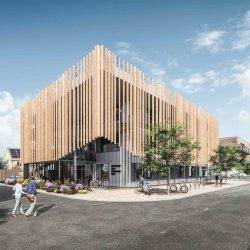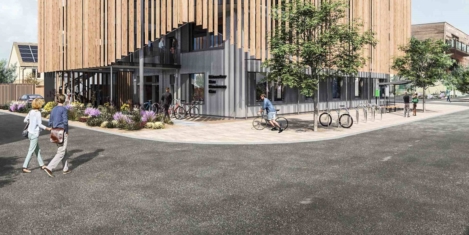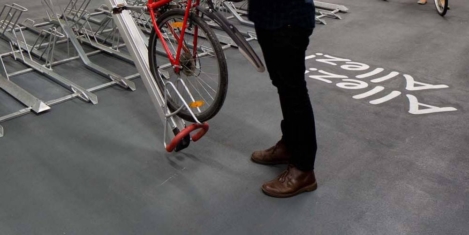To provide the best experiences, we use technologies like cookies to store and/or access device information. Consenting to these technologies will allow us to process data such as browsing behaviour or unique IDs on this site. Not consenting or withdrawing consent, may adversely affect certain features and functions.
The technical storage or access is strictly necessary for the legitimate purpose of enabling the use of a specific service explicitly requested by the subscriber or user, or for the sole purpose of carrying out the transmission of a communication over an electronic communications network.
The technical storage or access is necessary for the legitimate purpose of storing preferences that are not requested by the subscriber or user.
The technical storage or access that is used exclusively for statistical purposes.
The technical storage or access that is used exclusively for anonymous statistical purposes. Without a subpoena, voluntary compliance on the part of your Internet Service Provider, or additional records from a third party, information stored or retrieved for this purpose alone cannot usually be used to identify you.
The technical storage or access is required to create user profiles to send advertising, or to track the user on a website or across several websites for similar marketing purposes.
 Construction has begun on a new zero carbon business centre at the Elmsbrook development in Bicester, Oxfordshire. PERCH, Elmsbrook is one of two new coworking spaces brought to Bicester by Cherwell District Council (CDC) and is subject to support from European Regional Development Funding. The 1,400 sqm building will span three floors and accommodate up to 125 people. The council claims it will be unique in ‘providing local office space for individuals and small businesses in a highly sustainable building, meeting the standards of the North West Bicester Eco Town’ scheme.
Construction has begun on a new zero carbon business centre at the Elmsbrook development in Bicester, Oxfordshire. PERCH, Elmsbrook is one of two new coworking spaces brought to Bicester by Cherwell District Council (CDC) and is subject to support from European Regional Development Funding. The 1,400 sqm building will span three floors and accommodate up to 125 people. The council claims it will be unique in ‘providing local office space for individuals and small businesses in a highly sustainable building, meeting the standards of the North West Bicester Eco Town’ scheme.







 The creative industries sector accounted for over a third 35 percent) of take-up in the regional office market in the first half of the year, with this sector in particular driving the co-working revolution and the provision of flexible office space. Latest figures in CBRE’s H1 2017 Property Perspective, which monitors the performance of ten regional cities, overall, the UK’s regional office markets saw continued demand in the first half of 2017, with office take-up reaching 2.8 million sq ft, only slightly lower than the five-year average. For the first half of 2017, several cities witnessed improved levels of take-up when compared with the first half of 2016, these include Aberdeen, Edinburgh, Leeds and Manchester. Select locations such as Reading, Maidenhead and Watford also saw a continuation of record rents being set during the first half of the year, which has largely been driven by the delivery of new developments.
The creative industries sector accounted for over a third 35 percent) of take-up in the regional office market in the first half of the year, with this sector in particular driving the co-working revolution and the provision of flexible office space. Latest figures in CBRE’s H1 2017 Property Perspective, which monitors the performance of ten regional cities, overall, the UK’s regional office markets saw continued demand in the first half of 2017, with office take-up reaching 2.8 million sq ft, only slightly lower than the five-year average. For the first half of 2017, several cities witnessed improved levels of take-up when compared with the first half of 2016, these include Aberdeen, Edinburgh, Leeds and Manchester. Select locations such as Reading, Maidenhead and Watford also saw a continuation of record rents being set during the first half of the year, which has largely been driven by the delivery of new developments.












 Commercial property occupiers remain cautious about the future, and hard data indicates that demand has, so far, been largely unaffected by Brexit, claims a new report from the British Council for Offices (BCO) . ‘Brexit and its Potential Impact on Office Demand’, examines how Brexit might impact on demand for office space on a national and regional basis through to 2022. According to the report, almost one year on from the Brexit vote the situation is one of uncertainty, feeding through to slower growth, with ‘an almost palpable sense that choppy waters lie ahead, particularly with regard to trade and movement of labour’. However, businesses continue to make long-term investments in the national economy and even in the City, some large investment banks have committed to large new office buildings. There is much variation in the relative performance of the UK’s major office centres, though, with some expanding and others apparently in decline.
Commercial property occupiers remain cautious about the future, and hard data indicates that demand has, so far, been largely unaffected by Brexit, claims a new report from the British Council for Offices (BCO) . ‘Brexit and its Potential Impact on Office Demand’, examines how Brexit might impact on demand for office space on a national and regional basis through to 2022. According to the report, almost one year on from the Brexit vote the situation is one of uncertainty, feeding through to slower growth, with ‘an almost palpable sense that choppy waters lie ahead, particularly with regard to trade and movement of labour’. However, businesses continue to make long-term investments in the national economy and even in the City, some large investment banks have committed to large new office buildings. There is much variation in the relative performance of the UK’s major office centres, though, with some expanding and others apparently in decline.


 Companies in the tech and media (TMT) sector have accounted for the greatest proportion of City take up so far this year new figures from Savills suggest. This is the largest amount of take up ever by this sector in the first five months of a year, representing a 20 percent share of the market, ahead of the professional services sector at 17 percent and insurance and financial services sector at 14 percent. TMF firms took 517,069 (48,036 sq m) of space out of a total of 2.25 million sq ft (208,699 sq m) to the end of May 2017. Key deals to complete in the City recently include visual effects company Industrial Light & Magic (owned by the Walt Disney Corporation) taking 47,010 sq ft (4,367 sq m) at Lacon House in the City fringe (Theobalds Road, WC1), joining other tech companies Argus and Exterion Media in the building.
Companies in the tech and media (TMT) sector have accounted for the greatest proportion of City take up so far this year new figures from Savills suggest. This is the largest amount of take up ever by this sector in the first five months of a year, representing a 20 percent share of the market, ahead of the professional services sector at 17 percent and insurance and financial services sector at 14 percent. TMF firms took 517,069 (48,036 sq m) of space out of a total of 2.25 million sq ft (208,699 sq m) to the end of May 2017. Key deals to complete in the City recently include visual effects company Industrial Light & Magic (owned by the Walt Disney Corporation) taking 47,010 sq ft (4,367 sq m) at Lacon House in the City fringe (Theobalds Road, WC1), joining other tech companies Argus and Exterion Media in the building.








August 23, 2017
I’ve got some real estate here in my bag
by Paul Carder • Comment, Flexible working, Property, Technology
We’ll marry our fortunes together.
I’ve got some real estate
Here in my bag.
So we bought a pack of cigarettes,
And Mrs. Wagner’s pies,
And walked off
To look for America.
“Kathy”, I said,
As we boarded a Greyhound in Pittsburgh,
Michigan seems like a dream to me now.
(more…)